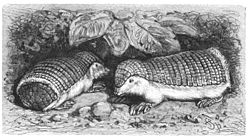Armadillo
| Armadillos Temporal range:Palaeocene–Recent
| |
|---|---|

| |
| Nine-banded Armadillo | |
| Scientific classification | |
| Kingdom: | |
| Phylum: | |
| Class: | |
| Superorder: | |
| Order: | Cingulata
|
| Families | |
| |

Aarmadillois in theCingulata,anorderofNew Worldplacentalmammals.The living ones have aleatheryarmoredshell. The wordarmadilloisSpanishfor "little armored one".
There are about 10livinggeneraand about 20speciesof armadillo. Their average length is about 75centimeters(30 in), including the tail. Thegiant armadillogrows up to 100 cm (39 in) and weigh 30 kg (66lbs). All species live in theAmericas.Most of the 20 species are found in open areas, such asgrasslands,but some also live inforests.[1]
Armadillos species are mostly found inSouthandCentral America,especially aroundParaguay.Many species areendangered.[2]
Embryology
[change|change source]The nine-banded armadillo has an unusualreproductivesystem, in whichgeneticallyidenticalquadrupletsare born in each litter.[3][4][5]
Because they are alwaysgeneticallyidenticalclones,the group of four young is a good subject for scientific, behavioural or medical tests. They provide the same biological and genetic makeup, and then get different treatment. This is the only regular case of 'polyembryony' in the classMammalia,where one fertilised egg splits into four embryos. It only happens in the genusDasypus,and not in all armadillos. Other animals which have this reproductive method areparasitoidwasps,certainflatwormsand various aquaticinvertebrates.[4]
Classification
[change|change source]Order CINGULATA
- †FamilyPampatheriidae:giant armadillos
- †FamilyGlyptodontidae:glyptodonts
- FamilyDasypodidae:armadillos
- SubfamilyDasypodinae
- SubfamilyTolypeutinae
† indicates extinct taxon
References
[change|change source]- ↑ "armadillo (mammal): Introduction -- Britannica Online Encyclopedia".Retrieved2012-06-08.
- ↑"Giant Armadillo: Natural History Notebooks".Retrieved2012-06-08.
- ↑"The Nine-banded Armadillo (Dasypus novemcinctus)".Edis.ifas.ufl.edu.Retrieved2009-12-17.
- ↑4.04.1Loughry, W.J; Prodohl, Paulo A; McDonough, Colleen M; & Avise, John C (May–June 1998),"Polyembryony in Armadillos"(PDF),American Scientist,86(3): 274–279,Bibcode:1998AmSci..86..274L,doi:10.1511/1998.3.274,S2CID196608283,archived fromthe original(PDF)on 2012-02-13,retrieved2012-02-21
{{citation}}:CS1 maint: multiple names: authors list (link) - ↑Hamlett, G.W.D (September 1933), "Polyembryony in the Armadillo: genetic or physiological?",The Quarterly Review of Biology,8(3): 348–358,doi:10.1086/394444,JSTOR2808431,S2CID86435985
